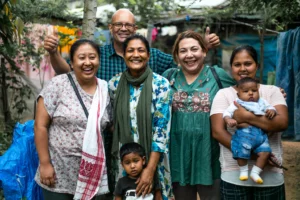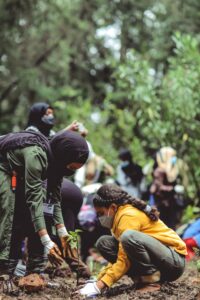If you’re a business that’s looking to fulfill the E in ESG genuinely and authentically but feel overwhelmed with not knowing where to begin, look no further. At Communique our team of Environmental, Social, and Governance (ESG) business model integration and corporate communication specialists can assist you in driving your businesses in the right direction.
Where do you start?
In an ever-changing world, with the growing pressures of climate change, every entity is faced with the responsibility to adapt, grow, and learn. When governments start rolling out regulations, businesses often wonder where to begin. Incorporating something that hasn't been a priority for a long time can be challenging, but it's not impossible.
One way to answer the question of where to begin may lie in an often-overlooked part of your business model: your local communities. Engaging with local communities can help you both meet sustainability goals and foster authentic loyalty.

Investing in this sustainability measure creates positive outcomes for all involved, including businesses, society, and the earth. Here are some valuable reasons to focus on local community engagement along with some practical tips for application.

Local communities often possess a wealth of knowledge, resources, and skills that can be harnessed to achieve sustainability goals. For example, you can learn sustainable land management practices from indigenous communities, sustainable agriculture techniques from local farmers and gardeners, and collaborate with local environmental initiatives that have already made a significant impact in the community. Additionally, non-profits that work effectively in the area can offer valuable insights.
Collaborating with local communities and tailoring their needs to what your business can offer is a great way to utilize their valuable knowledge and start building connections. This method is often overlooked, but many local communities lack resources that businesses can help provide. By doing so, you align your goals and can meet regulations, depending on the context. This not only benefits the environment and the community, but it can also create opportunities for collaboration and partnership.
For example, the home furnishing brand IKEA’s MÄVINN collection features local artisan created home accessories made of leftover denim, and banana barker fibers. Banana bark fibers are a waste by-product from banana farming that are utilized in this collection to create lampshades. The techniques and skills used to do this come from local artisans from India, Bangladesh, Thailand and Vietnam.
In order to do this IKEA collaborates with companies like India’s first community owned craft brand Rangsutra, to employ thousands of local artisans. These artisans use their local Indian art and craft heritage of their respective communities to create sustainable handmade pieces. The skills the artisans provide matched with the financial support of companies like IKEA creates sustainable livelihoods for the artisans and reduces IKEA’s waste footprint. This is one of the many ways various businesses can collaborate with local communities to increase environmental sustainability and reduce their climate footprint.
Here are some practical tips that businesses can use to implement this:
Establishing and maintaining customer loyalty is vital to ensuring the success of a business. Successful businesses prioritize their customers as key participants and collaborators.
When businesses prioritize the needs of local communities and take sustainable actions to address those needs, it can create a sense of loyalty and trust between the business and the community. This can lead to increased support for the business, as well as positive social and environmental impacts.
Loyalty towards businesses becomes even stronger when local communities can witness the efforts made by businesses towards a brighter future. Today, consumers, especially millennials and Gen Z, highly prioritize brands and businesses that take positive actions towards the betterment of society and the environment. Evaluating business ethos before purchasing has become common among many Gen Z's. When businesses support local communities in a sustainable way, it not only helps the environment but also increases the loyalty base from customers who value such actions.
For example, the outdoor clothing retailer Patagonia created the platform Patagonia Action Works where they showcase the local grassroots initiatives they support. They also connect their customers to their initiatives and provide space for their customers to inquire further and collaborate with the initiatives listed on their platform. Also included in the Patagonia Action Works is their Worn Wear program where customers can practice sustainability by trading in their worn Patagonia clothing or buying used Patagonia clothing items.
Due to their efforts, they have a loyal customer base, especially by Gen Z and Gen Y (Millennials) customers who highly value company environmental efforts. An article by Catherine Morin on Crm.org explains “Patagonia’s Customer Base and the Rise of an Environmental Ethos” and the extent to which environmental efforts are important to customers. Capgemeni Research Institute’s 2022 consumer behavior tracker “found that nearly 80% of consumers want to contribute to the fight to save the planet for future generations” (Capgemeni2022). The evidence clearly shows the rise of the conscious consumer and collaborating with local communities sustainably can ensure the longevity of your business and the earth.
Here are some practical tips that businesses can use to implement this:
In conclusion:
Listening to local communities is the optimum investment in longevity. One way to grow as a business is to listen to local communities and adapt to their needs, this ensures the business remains relevant and successful.
This requires understanding all aspects of sustainability, including environmental, social, and economic factors. By considering these different dimensions of sustainability, businesses can shift their perspective and view sustainability not as a task to be checked off, but as a cultural shift within the company.
This approach results in a business that is built to last and can adapt to changing perspectives and practices. Investing in longevity in this case means taking the necessary steps to ensure that as local communities grow due to their needs being met, the business also grows with them.
When local communities see businesses listening to them, engaging with them, utilizing their knowledge, being transparent, and including them in decision-making processes, it uplifts the community. They now have a business that not only aligns with many sustainable development goals, but also invests in a brighter future for all.
As we all strive towards sustainability, it's important to prioritize progress over perfection and acknowledge the efforts of all stakeholders, including businesses, governments, and society as a whole. By consistently trying to do better, we can collectively build a brighter and more sustainable future. Set up a consultation with Communique to help you get started.
What now?
Set up a consultation with Communique to help you get started. With Communique’s plethora of experience, you’ll be connected, guided and delivered an ESG framework that will help you meet your ESG goals. It’s time to shape your ESG story and Communique has the tools and methodology to do just that.
Author: Maha Abdel-Karim, Junior Environmental Consultant
Photo credit:
https://unsplash.com/photos/FyCjvyPG9Pg /
https://unsplash.com/photos/1qfy-jDc_jo //
https://unsplash.com/photos/m3I92SgM3Mk //
https://thehouseproject.foundation/blogs/blog/empowering-local-communities